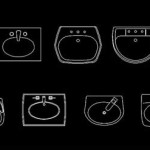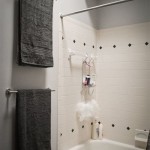Hanging Bathroom Sink Cabinets: A Comprehensive Overview
Hanging bathroom sink cabinets, also known as wall-mounted vanities or floating vanities, represent a versatile and increasingly popular design choice for modern bathrooms. They offer a sleek aesthetic, provide functional storage, and contribute to a sense of spaciousness. This article provides a comprehensive overview of hanging bathroom sink cabinets, exploring their advantages, disadvantages, design considerations, installation requirements, and maintenance aspects.
The fundamental characteristic of a hanging bathroom sink cabinet is its installation method. Unlike traditional floor-standing vanities, these cabinets are mounted directly to the wall, leaving the floor space beneath them unobstructed. This design element significantly alters the visual perception of the bathroom, creating a lighter and more open feel. The exposed floor area allows for easier cleaning and maintenance, effectively eliminating hard-to-reach corners where dust and grime tend to accumulate.
The selection of a hanging bathroom sink cabinet requires careful consideration of various factors, including the size and layout of the bathroom, the desired storage capacity, the overall aesthetic, and the structural integrity of the wall. Understanding the nuances of these factors is crucial for choosing the right cabinet that meets both functional and aesthetic requirements.
Key Advantages of Hanging Bathroom Sink Cabinets
Several key advantages make hanging bathroom sink cabinets an appealing option for bathroom renovations and new constructions. These advantages often outweigh the potential drawbacks, making them a preferred choice for homeowners seeking a modern and functional bathroom design.
Firstly, the space-saving benefit is paramount. By freeing up floor space, these cabinets make smaller bathrooms feel significantly larger. The visual trickery of seeing more floor area creates an illusion of increased size. This is particularly beneficial in compact bathrooms where maximizing available space is a priority. Furthermore, the open space beneath the cabinet allows for easier maneuvering within the bathroom, enhancing accessibility and comfort.
Secondly, the ease of cleaning is a significant advantage. With no floor contact, there are no awkward corners or crevices to clean around. Spills and splashes can be easily wiped up without the need for bending or reaching into tight spaces. This reduced cleaning effort contributes to a more hygienic and manageable bathroom environment. Robot vacuums can also easily navigate under the cabinet, providing automated cleaning solutions.
Thirdly, hanging vanities often offer a modern and contemporary aesthetic. Their clean lines and floating appearance contribute to a minimalist and sophisticated look. They can be easily integrated into various design styles, from sleek and modern to Scandinavian and transitional. The wide variety of materials, finishes, and hardware options allows for customization to match the overall bathroom décor.
Disadvantages and Considerations
While hanging bathroom sink cabinets offer numerous benefits, it is important to acknowledge potential disadvantages and considerations that may influence the decision-making process. These considerations relate to structural requirements, installation complexities, and potential limitations in storage capacity.
One major consideration is the wall’s structural integrity. Hanging cabinets require a robust wall structure capable of supporting the weight of the cabinet, the sink, and any items stored inside. Ideally, the cabinet should be anchored to wall studs. If studs are not ideally located, additional framing or reinforcement may be required to ensure secure and stable installation. Drywall alone is generally insufficient to support the weight, and specialized mounting hardware is essential. This might necessitate consulting with a contractor or structural engineer to assess the suitability of the wall before installation.
Another disadvantage can be potential limitations in storage capacity. Compared to some floor-standing vanities, hanging cabinets may offer less storage space, particularly in terms of height and depth. The design focus on a minimalist aesthetic often results in a smaller cabinet footprint. Homeowners with extensive storage needs might need to supplement the cabinet with additional shelving or storage solutions. Careful assessment of storage requirements is crucial during the selection process.
Installation can be more complex compared to floor-standing vanities. Accurate measurements, precise drilling, and secure anchoring are essential for a successful installation. Improper installation can lead to instability, sagging, or even the cabinet detaching from the wall. Professional installation is often recommended, especially for heavier cabinets or when dealing with complex plumbing configurations. The cost of professional installation should be factored into the overall budget.
Design and Style Options
Hanging bathroom sink cabinets are available in a vast array of designs and styles to suit various aesthetic preferences and bathroom layouts. The choice of material, finish, cabinet configuration, and sink type plays a significant role in the overall look and feel of the bathroom.
Cabinet materials commonly include wood, MDF (Medium-Density Fiberboard), plywood, and metal. Solid wood offers durability and a classic aesthetic, but it can be more expensive and requires proper sealing to prevent moisture damage. MDF is a cost-effective alternative that provides a smooth surface for painting or finishing. Plywood offers a balance of strength and affordability. Metal cabinets provide a modern and industrial look, often incorporating stainless steel or powder-coated finishes.
Finishes range from paints and stains to laminates and veneers. Painted cabinets offer a wide range of color options, while stained cabinets highlight the natural grain of the wood. Laminates provide a durable and water-resistant surface, available in various colors and patterns. Veneers offer the look of solid wood at a more affordable price point.
Cabinet configurations include single-door, double-door, drawer-based, and open-shelf designs. The choice depends on the specific storage needs and the desired aesthetic. Drawers offer convenient access to frequently used items, while doors provide concealed storage. Open shelves can be used to display decorative items or store towels. Combination designs incorporating both drawers and doors are also available.
Sink options are equally diverse, including undermount sinks, vessel sinks, and integrated sinks. Undermount sinks create a seamless transition from the countertop to the sink, offering a clean and modern look. Vessel sinks sit on top of the countertop, adding a distinctive design element. Integrated sinks are molded directly into the countertop, providing a seamless and hygienic surface. The choice of sink style should complement the overall design of the cabinet and the bathroom.
Installation Process and Considerations
The installation of a hanging bathroom sink cabinet requires careful planning and execution to ensure a secure and aesthetically pleasing result. The process involves several key steps, including preparing the wall, marking the mounting points, installing the mounting hardware, and connecting the plumbing.
Before starting the installation, it is crucial to locate the wall studs and verify their load-bearing capacity. A stud finder can be used to accurately locate the studs. If the studs are not ideally positioned for mounting the cabinet, additional framing or reinforcement may be required. The water supply lines and drainpipe should also be located and assessed to ensure they are compatible with the cabinet's plumbing connections.
The mounting height of the cabinet should be determined based on the user's height and comfort. A standard height is typically between 32 and 36 inches from the floor to the top of the sink. Once the height is determined, the mounting points should be accurately marked on the wall using a level and a measuring tape. It is essential to ensure that the mounting points are perfectly level to prevent the cabinet from sagging or tilting.
The mounting hardware should be chosen based on the weight of the cabinet and the type of wall construction. Heavy-duty brackets or mounting rails are typically recommended for hanging vanities. The hardware should be securely attached to the wall studs using screws or bolts. If the studs are not accessible, specialized anchors designed for drywall or plaster can be used, but their load-bearing capacity should be carefully considered.
Once the mounting hardware is installed, the cabinet can be carefully lifted into place and attached to the hardware. Ensure the cabinet is level and securely fastened before proceeding with the plumbing connections. The water supply lines and drainpipe should be connected according to the manufacturer's instructions.
After the plumbing is connected, test for leaks and make any necessary adjustments. Seal the edges of the cabinet with caulk to prevent water damage. Clean the cabinet and surrounding area to complete the installation.
Maintenance and Care
Proper maintenance and care are essential for preserving the appearance and extending the lifespan of a hanging bathroom sink cabinet. Regular cleaning, prompt attention to spills, and preventative measures can help keep the cabinet looking its best for years to come.
Regularly clean the cabinet with a mild soap and water solution. Avoid using harsh chemicals or abrasive cleaners, as they can damage the finish. Wipe up spills immediately to prevent staining or water damage. Pay particular attention to areas around the sink and faucet, where water is likely to accumulate.
Check the plumbing connections periodically for leaks. Address any leaks promptly to prevent water damage to the cabinet and surrounding areas. Inspect the mounting hardware to ensure it remains secure and that the cabinet is not sagging. Tighten any loose screws or bolts as needed.
Protect the cabinet from excessive moisture. Ensure the bathroom is well-ventilated to prevent the buildup of humidity. Consider using a dehumidifier in bathrooms with poor ventilation. Avoid placing wet towels or other damp items directly on the cabinet surface.
By following these maintenance and care guidelines, homeowners can ensure that their hanging bathroom sink cabinet remains a stylish and functional element of their bathroom for many years.

Wall Mounted Hanging Floating Bathroom Cabinet Tw 2202

Modern 39 Floating Black Bathroom Vanity Stone Top Wall Mounted Cabinet Interior Design

Elegant Wall Mounted White Bathroom Vanity Unit And Sink Basin Home Furniture

5 Practical Advantages Of Wall Hung Bathroom Vanity Cabinets Basin

Hanging Bathroom Cabinets Stainless Steel Vanity Wall Hung Cabinet Ts6017 China Made In Com

Buy Sonix 800 2 Draw Wall Hung Bathroom Vanity Unit Grey

Wall Mounted Bathroom Cabinet Ideas Designcafe

Vapsint 30 In W X 18 D 24 H Wall Mounted Bathroom Vanity White With Ceramic Sink Hesebc049 Cz 75e 1 The Home Depot

600mm White Wall Hung Countertop Vanity Unit With Marble Effect Basin And Shelves Lugo Better Bathrooms

Wall Hang Bathroom Vanity Cabinet With Above Basin Mcp 7006
Related Posts







